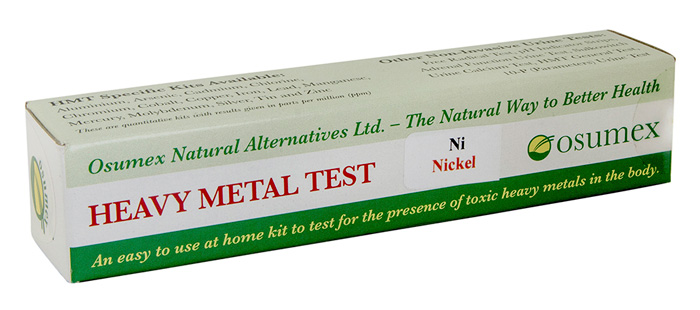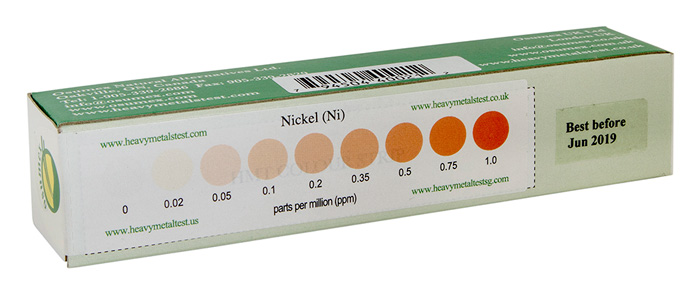|
| Water Test Kit (2-test pack) |
| Adrenal Function Urine Test |
| Sulkowitch Urine (Calcium) Test |
|
|
|
NICKEL
Number 28 on the "periodic table" of elements
Tests the presence of ions of nickel to a high degree of accuracy to
detect contamination in the body and on a wide range of materials in your environment
Nickel is a naturally occurring metal existing in various mineral forms and may be found throughout the environment
including rivers, lakes, oceans, soil, air, drinking water, plants, and animals. Soil and sediment are the primary
receptacles for nickel. Nickel has no known biological function, and is of medium toxicity to humans.The organic
form of nickel is much more toxic than its inorganic forms. It is highly irritant to the skin, and is toxic to the
cardiovascular system, as well as being carcinogenic
Nickel is released into the atmosphere from burning fossil fuels, mining and refining operations and incineration of
municipal waste. It is also found in soil treated with sewage sludge, and in cigarettes, which contain between 0 and
0.51 micrograms per cigarette. Skin exposure may occur when jewellery which contains nickel is worn. Once in the body,
nickel can replace metals in metallo-enzymes and cause disruption of metabolic pathways. The most toxic of nickel
compounds is nickel carbonyl, a very volatile liquid at room temperature, which is known to be a lung carcinogen when
inhaled.
Generally and unknowingly we ingest a daily average of 170 micrograms of nickel. This may come from the air we breath,
the water we drink and the food we eat. Most of the nickel absorbed goes to the kidneys. Nickel consumed are usually
disposed off in the feces quickly while those that get into the bloodstream are sliminated through the urine.
Sources
Nickel exposure and absorption into the body can come from teh following sources::
- Atmosphere - nickel in air is attached to small particles. The average concentration of nickel of nickel in the air
in US is about 1 - 86 nanograms/m3 (1 ng/m3 is equivalent to 1 billionth of a gram in a cubic metre of air).;
- Water - the nickel concentration in water from rivers and lakes is very low. It is generally not more than 10 parts
in a billion (ppb). The average concentration of nickel in drinking water is around 2 ppb;
- Soil - soil generall contains about 4 - 80 ppm. unless the soil is near mining activities especially where nickel is
extracted. It has been known for nickel concentration in these areas to be as high as 9,000 ppm. Contact from nickel in
soil is generally through the skin although children may get it by eating the soil;
- Food - food naturally high in nickel are chocolate, soy beans, nuts, and oatmeal. It is possible that you can be exposed
to nickel through contact with food containers containing nickel;
Toxicity
Eating higher levels of nickel normally found in food has been found to cause lung diseases in dogs. It affects the stomach,
bllod, liver, kidneys and the immune system in rats and mice. High levels of nickel consumption have been shown to cause birth
defects in rats and mice. The most common adverse health effect of nickel in humans is an allergic reaction. People can become
sensitive to nickel when jewelery and other things come into contact with the skin. Workers who accidentally consumed water
contaiminated with high levels of nickel (250 ppm) had stomach aches and suffered adverse effects to the blood and kidneys. A
child who ate 5,700 milligrams of nickel as crystals of nickel sulfate died of heart failure. .
Toxicity Symptoms
Nickel can affect the stomach, lungs, kidneys and blood of the body. Nickel caused increased red blood cells. The most serious
effect of nickel has been cancer of the lungs and nasal sinus. However, these were the result of long exposure to high levels of
nickel in industrial work places. High exposure can cause cough, shortness of breath, and fluid in lungs
Toxicity Limits
The average daily absorption of nickel is minimal - no more than 200 microgram. People who are not sensitive to nickel must ingest
very large amounts to show adverse health effects. It is therefore more important to ensure that there is no ongoing long term than
short term exposure to nickel contamination. Ideally concentration levels of organic and inorganic nickel should be 0.
Check out lead levels in your body and the environment with our easy to use, home-based, Nickel
Test kit
 
Nickel HMT kit
Osumex HM-Chelat is most effective in eliminating heavy metals contamination in the body

The above information is provided for general
educational purposes only. It is not intended to replace competent
health care advice received from a knowledgeable healthcare professional.
You are urged to seek healthcare advice for the treatment of any
illness or disease.
Health Canada and the FDA (USA) have not evaluated these
statements. This product is not intended to diagnose, treat, cure, or prevent
any disease.
|


